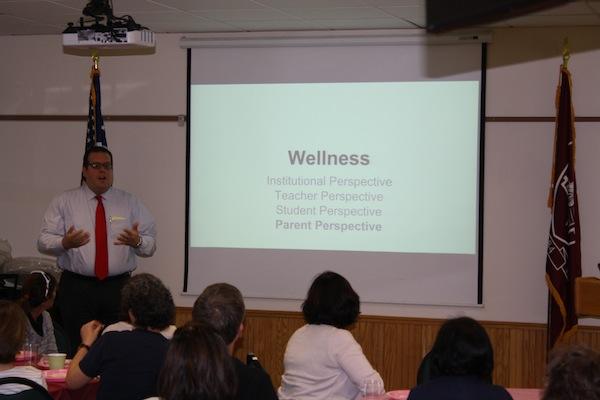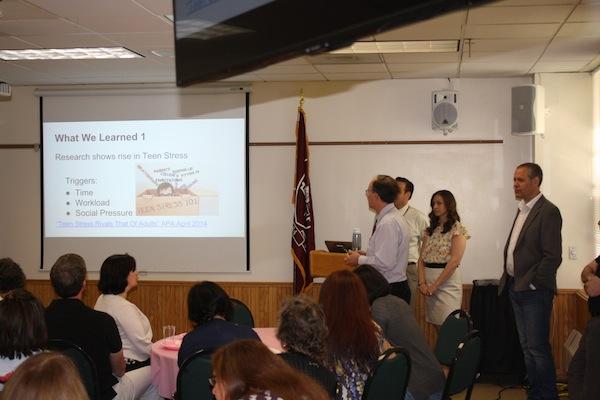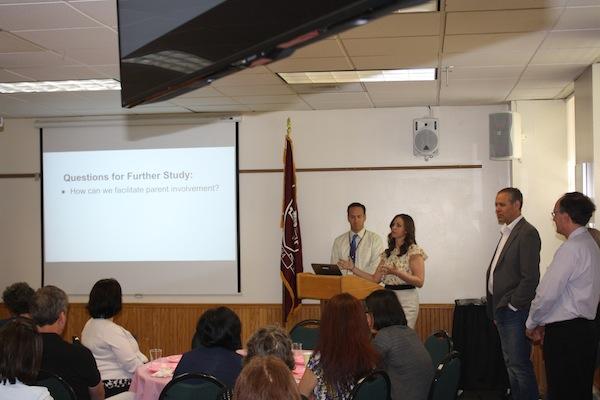Reducing Stress at Scarsdale High School
- Tuesday, 19 May 2015 09:24
- Last Updated: Wednesday, 20 May 2015 09:27
- Published: Tuesday, 19 May 2015 09:24
- Hits: 8215

According to the experts, there has never been a more stressful time to be a high school student. Faced with a demanding workload, time pressure from extra curricular activities and sports and the ever-present need to excel at everything they do, many students feel like there are just not enough hours in the day or night. A 2014 study by the American Psychological Association found that teens stress levels surpass those of adults and that teens' stress levels exceed what they believe to be healthy. As a result of stress, the 1,018 teens in the study reported feeling overwhelmed, depressed, sad and fatigued.
In order to address this issue, Scarsdale High School is studying sources of stress and what can be done to alleviate it. Their initial findings were the subject of a meeting of the SHS PTA on the morning of Thursday May 7th.
The school has begun by identifying itself as one of a teen's many sources of stress and has asked the faculty to study institutional practices, teacher practices and students perspectives on stress. Three groups, each with about 50 teachers, studied the stressors and presented their findings. 
English teacher George Olivier identified the institutional practices of the school that cause stress. Based upon research that he and his group of teachers had done, and based on personal experiences that teachers had with other schools that their own children attend, they identified some practices that Scarsdale could improve. Mr. Olivier began by examining teen stress and why it is rapidly approaching, if not surpassing stress among adults. Unlike adults, teens don't have the same mechanisms to deal with stress, and sometimes suffer more than their parents. According to Olivier, one way to address the problem of stress would be to change the atmosphere in the high school. He said that Scarsdale is a competitive school, with a "business like" feel. Students may feel that rather than entering a school they are coming into an office complex. His group of teachers looked for small ways the school could change, reduce, or manage student stress. They recommended lengthening the lunch period, beginning the day later, implementing mandatory study periods and even mandating lighter or nonexistent homework on weekends and vacations. While at this point these are just ideas they are a good starting point.
Fellow English teachers Benjamin Sawyer and Rachel Warshowsky focused on what teachers can do to help students reduce or manage stress. They suggested that teachers make the classroom feel more like a community and recommended that teachers make an effort to relate to students and demonstrate that they "aren't just robots that disappear at the end of the day," as Warshowsky explained. In a humanized teaching environment with better student-teacher relations, students might feel less stress while doing their typical daily work. In order to improve relations, the teacher panel suggested that teachers attend students' sports and musical events and take an interest in their students' extracurricular activities.
The teachers examined the difference between stress reduction and stress management. Teachers believe that their students will face stress in the future, so that stress at school will help them develop good coping skills and stress management techniques. At the same time studies are showing that students have very high stress levels, and so the added stress put on them by teachers may actually be more of a hindrance than a help. Teachers are discussing how to teach stress management and determining whether this should be the subject of a new class or taught in every class. They felt that this deserved further inquiry as the school begins to fix the issue.
 English teacher Seth Evans and Dean Oren Iosepovici presented the student's perspective on stress. Dean Iosipovici contended that this was the hardest topic, saying, "Our challenge as teachers and adults is to look at it the way students look at it." In order to meet this challenge, this group of teachers got students involved in the process early, having discussions and posing panel questions to student volunteers, to delve into the issue of what causes stress for the students, and how they react to and deal with that stress. The group found that some students were handling their stress using good techniques while others have a great deal of stress and lack the skills to deal with it.
English teacher Seth Evans and Dean Oren Iosepovici presented the student's perspective on stress. Dean Iosipovici contended that this was the hardest topic, saying, "Our challenge as teachers and adults is to look at it the way students look at it." In order to meet this challenge, this group of teachers got students involved in the process early, having discussions and posing panel questions to student volunteers, to delve into the issue of what causes stress for the students, and how they react to and deal with that stress. The group found that some students were handling their stress using good techniques while others have a great deal of stress and lack the skills to deal with it.
As part of a group exercise, teachers attempted to return to their teenage selves and to experience stress as a teen would perceive it. Mr. Evans led the committee of teachers through a "memory chain," a technique to stimulate the recollection of past memories. He used the technique to "transport" the teachers back to their high school years, in order to better help them understand some of the typical teenage stress. According to Mr. Evans and Dean Iosepovici, the technique worked, and the teachers determined that the stress that they dealt with as teens was due to personal difficulties in their lives and seemed to be socially induced.
As a teen and a student at Scarsdale High School, I experience this stress firsthand. I juggle demands from many different sources, all at the same time. Though I want to do well at everything I do, I am forced to divide my time between studying and preparing for six classes, attending sports practice and participating in extracurricular activities. I also need to sleep in order to grow. I always feel as if I am sacrificing one activity for another and don't want to miss out on the fun of being in high school in order to meet all my obligations.
For most Scarsdale students the prospect of getting into college looms heavily over everything we do. We put pressure on ourselves to do our best, parents set goals that may not be attainable and each year we learn that it is harder and harder to get into the "right" school. That's why I was happy to learn that SHS is studying stress and looking for ways to make the school a happier, more productive learning environment.














